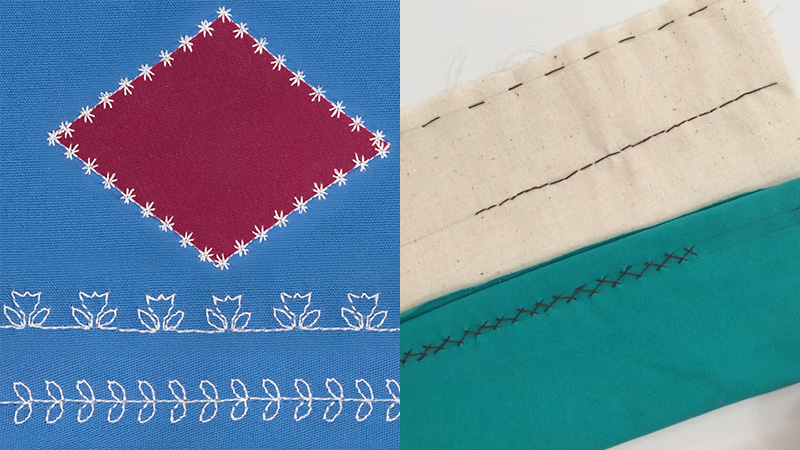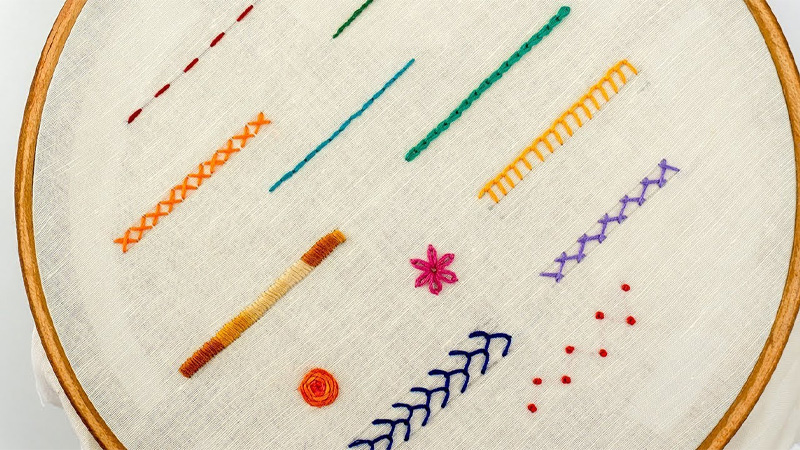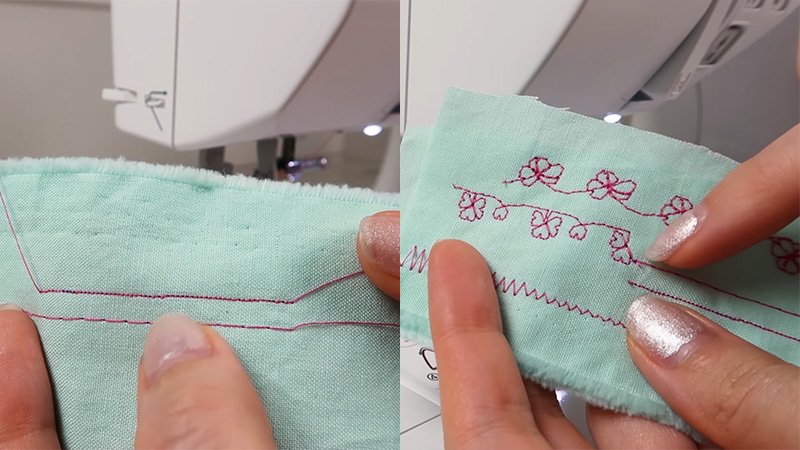In the world of sewing, stitching is the very essence of the craft. It’s the rhythmic dance of the needle and thread that transforms fabric into garments, quilts, and countless other creations.
Whether you’re a seasoned seamstress or a novice with a needle, understanding what stitching truly means is fundamental to mastering this age-old art.
In this enlightening exploration, we will answer what is stitching in sewing. We’ll uncover the various stitches that bring fabric to life, the tools that make it all possible, and the techniques that turn mere threads into intricate patterns.
Whether you’re seeking to mend, mend, or create, stitching is the bridge between imagination and reality in the sewing world.
So, let’s embark on this enlightening journey and unravel the beauty and precision of stitching in sewing, where creativity meets craftsmanship, one stitch at a time.

What Is Stitching in Sewing?
In sewing, stitching refers to the process of joining fabric layers together using a needle and thread. It’s a fundamental technique that forms the basis of all sewing projects.
Stitching serves various purposes, including creating seams, attaching fabric pieces, and adding decorative elements to garments and textiles. Here are the key aspects of stitching in sewing include:
Needle and Thread
Stitching involves passing a needle through the fabric while carrying a thread. The needle punctures the fabric, and the thread is pulled through, creating a connection between two or more fabric layers.
Seams
Seams are one of the primary outcomes of stitching. They are the lines of stitching that join fabric pieces together, creating the structure of garments and other textile items.
Stitch Types
There are numerous types of stitches, each with its purpose and appearance. Common stitch types include straight stitches, zigzag stitches, basting stitches, and decorative stitches. The choice of stitch depends on the project’s requirements.
Machine and Hand Stitching
Stitching can be done using a sewing machine or by hand. Sewing machines are commonly used for efficiency, while hand stitching allows for greater precision and control, especially in delicate or intricate work.
Purpose
Stitching serves functional and decorative purposes. Functional stitches secure fabric layers, create darts, pleats, and gathers, and assemble garments and other textile items. Decorative stitches add embellishments and intricate patterns to enhance the aesthetics of the project.
Thread Choice
The choice of thread depends on the project’s requirements, fabric type, and desired appearance.
Threads come in various materials, colors, and thicknesses, and selecting the right thread is essential for achieving durable and visually appealing stitching.
In essence, stitching is the art and skill of using a needle and thread to manipulate fabric, allowing individuals to bring their creative ideas to life, mend clothing, and construct a wide range of items, from clothing and accessories to home decor and quilts.
What Are the Different Types of Stitching?

There are various types of stitching in sewing, each serving specific purposes and creating different effects. Here’s an overview of some common types of stitching:
Straight Stitch
The straight stitch is the basic and most commonly used stitch. It’s a simple line of stitches created by moving the fabric forward while the needle goes up and down. Straight stitches are used for sewing seams, hemming, and topstitching.
Zigzag Stitch
Zigzag stitches are a series of slanted stitches that form a zigzag pattern. They are versatile and used for finishing fabric edges to prevent fraying, creating stretchy seams on knit fabrics, and adding decorative embellishments.
Basting Stitch
Basting stitches are long, temporary stitches used for holding fabric layers together temporarily. They are easily removed when no longer needed and are often used for fitting adjustments and gathering fabric.
Backstitch
The backstitch is a strong, secure stitch used for reinforcing seams. It involves stitching backwards to lock the stitches in place and then sewing forward. Backstitches are commonly used at the beginning and end of seams.
Topstitching and Blanket Stitch
Topstitching is a decorative or functional stitch done on the top side of the fabric, often along seams or edges. It adds a professional finish and can help secure seams or add embellishments.
The blanket stitch is commonly used for finishing fabric edges, especially on blankets and felt projects. It creates a looped pattern that resembles hand embroidery and helps prevent fraying.
Overlock Stitch (Serger Stitch) and Running Stitch
Overlock stitches are created using a serger machine and are used to finish fabric edges, preventing fraying. They are commonly seen on the inside of professionally made garments.
The running stitch is a basic hand-sewing stitch where the needle and thread move in and out of the fabric in a straight line. It’s often used for temporary stitching, quilting, and embroidery outlines.
Cross Stitch and Satin Stitch
Cross stitches form an X-shaped pattern and are primarily used in embroidery. They create intricate designs and are especially popular for decorative needlework on fabric.
Satin stitches are dense, closely spaced stitches used for filling in shapes or creating smooth, shiny surfaces. They are often used in embroidery and appliqué work.
Chain Stitch and Buttonhole Stitch
The chain stitch creates a linked loop pattern. It’s used for embroidery, outlining shapes, and creating decorative borders. Buttonhole stitches are used to reinforce and finish the edges of buttonholes. They create a sturdy, neat edge that prevents fraying.
Feather Stitch and Couching Stitch
Feather stitches resemble delicate feathers and are commonly used in embroidery and heirloom sewing for decorative effects.
Couching stitches are used for attaching a decorative thread or cord to the fabric surface using a second thread. They add texture and dimension to embroidery and embellishments.
Smocking Stitch
Smocking stitches create gathered and pleated patterns on fabric. They are often used in smocked garments and heirloom sewing.
These are just a few examples of the many types of stitching techniques in sewing. The choice of stitch depends on the project’s requirements, fabric type, and desired outcome, whether functional or decorative.
Mastering different stitching techniques is an essential skill for sewists and allows for a wide range of creative possibilities in sewing projects.
What Is the Difference Between Stitching and Sewing?

The terms “stitching” and “sewing” are closely related in the context of textile work, but they refer to slightly different aspects of the process:
Sewing
Sewing is a broad term that encompasses the entire process of joining fabric or materials together using a needle and thread. It includes various techniques, such as stitching, to create seams, attach fabric pieces, and construct garments, accessories, or other textile items.
Stitching
Stitching is a specific action within the sewing process. It refers to the act of creating individual stitches by passing a needle and thread through the fabric in a repetitive manner.
These stitches form the basic unit of sewing and can take various forms, such as straight stitches, zigzag stitches, or decorative stitches. Stitching is what holds the fabric layers together and is responsible for creating seams, embellishments, or decorative patterns on the fabric.
Sewing is the overarching process that involves various techniques, including stitching, to manipulate fabric and create textile items.
Stitching, on the other hand, is the act of forming individual stitches with a needle and thread, which is essential for sewing projects but represents just one aspect of the entire sewing process.
How to Stitch?
Stitching is a fundamental sewing skill that involves creating a series of interlocking loops using a needle and thread. Here’s a basic guide on how to stitch by hand:
Thread the Needle
Cut a length of thread (usually around 18-24 inches) and thread it through the eye of the needle. Tie a knot at the end of the thread to secure it.
Position the pieces of fabric or materials you want to stitch together. Make sure they are aligned and pinned in place if necessary.
Start from the Wrong Side
Insert the needle from the wrong side (the side you want to hide the knots and stitches) of the fabric and pull it through to the right side. Leave a small tail of thread on the wrong side.
Insert the needle back into the fabric, close to where it emerged, and pull it through. This creates your first stitch. The distance between the first stitch and the starting point determines the stitch length.
Continue Stitching
To create more stitches, insert the needle back into the fabric, this time a short distance from the first stitch. Pull the thread through to the right side to form the second stitch. Keep repeating this process, creating a series of evenly spaced stitches.
Securing the Stitch
To secure your stitches, make a small backstitch. After creating your last stitch, insert the needle into the fabric but bring it out slightly ahead of the last stitch. This will create a small loop. Pass the needle through this loop to secure the stitch.
Knotting the End
To finish the stitching, knot the thread on the wrong side of the fabric. You can do this by making a small loop with the thread and passing the needle through it, then pulling it tight to create a knot. Repeat if necessary for added security.
Press the Stitched Area
Use scissors to carefully trim any excess thread, leaving a small tail if needed. For a neat finish, press the stitched area with an iron if the fabric allows it. This will set the stitches and create a smooth appearance.
Practice stitching on scrap fabric to improve your technique. Use the appropriate needle and thread for your fabric type. Maintain even tension on the thread to create consistent stitches. Experiment with different types of stitches for various sewing projects.
Remember that hand stitching can be used for various purposes, including sewing seams, mending, adding decorative details, and creating handcrafted items. The more you practice, the more skilled you will become at creating neat and secure stitches for your sewing projects.
FAQs
What type of needle should I use for hand stitching?
The choice of needle depends on your project and fabric. For general sewing, a sharp or universal needle works well. For heavier fabrics, use a larger and stronger needle. Needles designed for specific tasks, like embroidery or quilting, are also available.
How can I prevent knots and tangles when hand stitching?
To prevent knots, always thread your needle with the tail end knotted. Additionally, hold the tail securely while making your first few stitches. Avoid pulling the thread too tight, as it can lead to tangles and knots.
What type of thread is best for hand stitching?
Use a thread suitable for your fabric. For most lightweight to medium-weight fabrics, all-purpose sewing thread works well. For heavy fabrics, consider a stronger thread. Silk or cotton thread is often used for delicate or special projects.
How do I choose the right stitch length for hand sewing?
The stitch length depends on your project. For secure seams, stitches should be evenly spaced and of a suitable length for the fabric’s thickness. Experiment on a scrap piece of fabric to find the desired stitch length for your project.
What is the best way to hide knots and thread ends when hand stitching?
To hide knots and thread ends, begin your stitching on the wrong side (the side facing in) of the fabric. When you finish stitching, bring the needle to the wrong side, create a small knot, and bury the thread end between the fabric layers.
Conclusion
Stitching in sewing is the fundamental and transformative process that gives life to fabric, turning it into garments, home decor, and works of art. It is the rhythmic interplay of needle and thread, guided by skill and creativity, that allows sewists to bring their visions to fruition.
Throughout this exploration, we have discovered the diverse world of stitching, from basic straight stitches to intricate decorative ones. We’ve also delved into the essential tools and techniques that make each stitch possible.
Whether you’re patching up a beloved pair of jeans or crafting a masterpiece from scratch, stitching is the common thread that binds all sewing endeavors.
As you continue your sewing journey, remember that each stitch holds the promise of creativity and the power to transform fabric into something truly remarkable. So, embrace the art of stitching, let your imagination soar, and sew your dreams into reality—one stitch at a time.
Leave a Reply